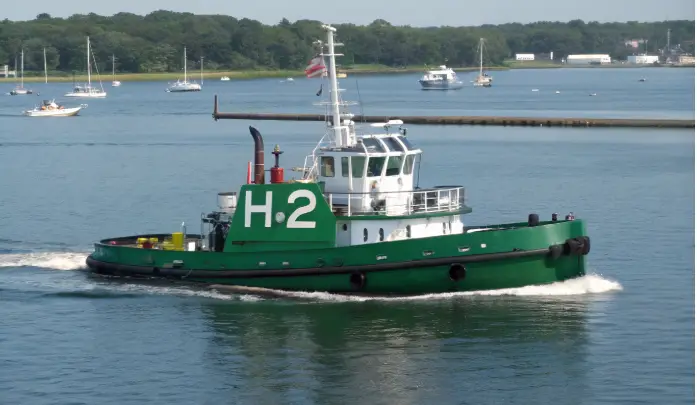
Japan Launches World’s 1st Hydrogen Dual-Fuel Tugboat | Tsuneishi Leads Marine Decarbonization
April 4, 2025The world marines market saw something of a coming-of-age in December 2023 when Japanese shipbuilder Tsuneishi Shipbuilding launched the very first tug with its power sulfur-capable molecular natural gas injected, which led Saigyo’ s demonstration from Norway to Japan. The award winning single sitter, which can be powered by hydrogen and traditional fuels represents an important milestone in global environmental initiatives to curb pollution emissions from fossil fuel burning vehicles. The adoption of this clean and green zero-emission technology is not going to improve Japan’s national hydrogen strategy, but also enabling the country led by their parliament as a leader in sustainability advances.
World’s First Hydrogen Dual-Fuel Tugboat
The tugboat is not a proof of concept, but rather an example that the practical use of hydrogen fuel cells and also dual-fuel technology with hydrogen can work even in one of perhaps most hostile environments on our planet: marine operation. Japan, with its rich shipbuilding history and maritime prowess conducts such initiatives that will lay down a path for the future where depleting environmental impact in marine transport is achieved.
Tsuneishi Shipbuilding, based in Fukuyama (established 1917) Japan. Moreover, a company which is known for its efficiency and reliability has recently welcomed emergent technology solutions such as hydrogen dual-fuel engines along with other clean energy innovations. The launch of the new tugboat is another demonstration of Japan’s overall dedication to ensuring maritime sector decarbonisation.
The attention-grabbing part is their distinct diesel engine, adapted to switch back and forth between hydrogen, electricity and plain ol’ fuel. These dual-fuel capabilities also mean that, using traditional means of propulsion if necessary in low-hydrogen scenarios to ensure continued operations. The engine upgrades, meanwhile, consist of high-pressure fuel injection systems as well as specially engineered combustion chambers to ensure reliable and safe operation on hydrogen dual-fuel.
Expected further technical specifications and the specific model of engine used remain unconfirmed, however this project appears to be a key intermediary milestone for zero-emission technology than more broadly applied at sea. Tsuneishi and its partners are not only at the forefront, but in conjunction with global environmental targets, such as that of the International Maritime Organization (IMO), they also set industry benchmarks for safe/clean hydrogen recirculation utilization while propulsion by ship.
The tugboat for the futureBy comparison, construction of this new-age tug comes during a period when technological revisions are alarming transport. Hydrogen has traditionally been received with mixed reactions, as questions surrounding production methods and storage capabilities along with infrastructural demands prevailed. Nonetheless recent progress has reinvigorated its promise as a linchpin in tomorrow’s power equation. As governments and industry evolve toward a greener, more sustainable future, hydrogen is at the heart of this transition with growing backing both publicly and privately.
Some other examples
Wider around the globe, other projects seem to be singing from a similar hymn-sheet about what we can expect in future with hydrogen based solutions. European projects, for example promoted the use of hydrogen in ferries and coastal patrol ships. They are illustrative examples that hydrogen fuel cells and dual-fuel engine systems make sense no matter what you’re trying to move about.
Finally, there are a few game-changing projects from powerhouse corporations which look to bring hydrogen fuel cells into not just maritime but heavy-duty land transport as well. But these projects are important because they demonstrate a trend that the world is beginning to accept hydrogen as an energy carrier for mobility and storage solutions in many countries on different continents.
Implications
The initial effect of putting this tug into service is a good excuse for rolling out the hydrogen dual-fuel engines regards it as exemplary and advantageous to improve upon in terms of technology. In the near future, these advancements will prompt further R&D in all sectors of maritime industry. They also tie into a changing regulatory environment that is becoming far more friendly to sustainable transportation.
OVER TIME, this effort can be expected to hasten movement towards a zero-emission tech future. Economically, the use of hydrogen-powered boats aligns with larger markets and also minimizes risks in technology investments (PPPs) as well as job creation at various stages of construction to completion involving fuel cells. The shipping industry needs to change from an environmental perspective but there is also another economic dimension playing in favour of reducing emissions — the demand for clean maritime transport increases as global standards on sea cleanliness are getting stricter.
Seen as environmentally friendly over the long term, they produce fewer greenhouse gases and less soot for port cities and are a key plank in fighting climate change. In terms of society, the action might also help encourage other element or show a legitimate willingness to sustainable improvement. What’s more, the economic ripple effects are immense with investments in clean energy technologies created downstream opportunities within related industries and infrastructure development.
Challenges and Opportunities
While it’s obvious that going off of fossil fuels to hydrogen is not problem-free. On the technology side of this, safely storing and handling hydrogen is complex but can be separated into two parts: creating advanced storage systems to retain compressed or liquefied fuel; closely studying the adoption of stringent safety standards. Another major challenge is in establishing a full hydrogen refueling network, particularly for maritime operations where logistical challenges abound.
But the opportunities exceed challenges by many orders of magnitude. For starters, the tugboat is handled a dual-fuel design. This minimises the risk associated with hydrogen supply disruptions, and opens up for wider use of hydrogen as it allows improved operational flexibility. While he told CNBC that rising investment in hydrogen fuel cells would scale production down and reduce costs – enabling wider adoption.
Performance and safety can be enhanced, as Toyota hydrogen technology has proven possible in the past (and other examples of breakthroughs without both design and engineering also frowned upon by traditionalists), HoweverDesignerEngineers a new way to adapt… The tugboat is a success for own reason, it validates all of the efforts to date on energy carriers made from hydrogen and opens up maritime applications that can now direct more consumer and investor ship towards these use-cases.
Call to Action/Future Outlook
In hindsight, the maritime industry is clearly on the cusp of a clean energy revolution. Tsuneishi Shipbuilding touts its new hydrogen dual-fuel tugboat as a monumental step that heralds the wider adoption of sustainable solutions for transportation. But reaching this vision will necessitate extensive coordination between governments, industry partners and technology enablers.
The message is clear to all of us, we must drive the emissions-free technologies in order for sustainable solutions can maintain and protect our planet for future generations. Here were some stepping for the business and technology community — this project might be a seatholder triggering more innovation with hydrogen technologies coming into play, it may urge companies around to offer something on similar level.
This tugboat launch likely set the stage for more high-profile projects in years to come. The journey is long, be it through improved fuel cell systems or hydrogen storage solutions jegñnyergnya or wide spread refuelling infrastructure. Japan Leads World; It Awaits Will As Hydrogen May Rewrite Energy Use for Multiple Market Sectors Perhaps to save the whales, or maybe just get a jump on its rivals and suppliers in China, where everything is happening.
Finally, tread lightly as the tide of this technological revolution sweeps us into a future where maritime transport is both clean and green. Tsuneishi Shipbuilding is doing more than building another tugboat, and it really opens the sail on a future of renewable energy, sustainable practices while keeping innovation in regard.
About Tsuneishi Shipbuilding: Founded in 1917, the Tsuneisihi Group has a solid foundation of building high quality vessels and advancing the limits of technology. Building on a rich heritage of traditional shipbuilding, the company has enhanced its competitive position with references in advanced hydrogen dual-fuel solutions and other clean energy repowering efforts from business lines.



 With over 15 years of reporting hydrogen news, we are your premier source for the latest updates and insights in hydrogen and renewable energy.
With over 15 years of reporting hydrogen news, we are your premier source for the latest updates and insights in hydrogen and renewable energy.
How will this breakthrough influence the economy of SIDS – Small Islands Development ?
SIDS are vulnerable as climatic change have made them more vulnerable to disasters and pollution. How can they shift to a hydrogen economy to protect themselves and the planet? What are the costs implications? Can Japan through JICA support SIDS port authorities acquire such tugs at concessionary prices by supporting both their supplier and the small buyers?